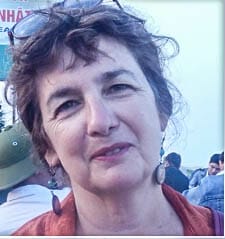Auditorium Theatre Awakens to Shen Wei Dance Arts'Rite of Spring
It seems like an oversized chalkboard put flat on the floor, perhaps with some foreign hopscotch-like game’s pentimento lingering.
Two dancers file slowly in and move to the edges, two more, and again, and again….
As they walk in—they take position silently, then shuffling. The later ones seem to dispel earlier ones in place as if they are two magnets repelling. The energies settle to still, then erupt again. It is an other worldly chessboard, with only pawn pieces. It’s quiet.
This assembly into place has the feel of a ritual. It has gathered our focus, slowed our minds and perhaps the dancers’ breath.
[embedyt]https://www.youtube.com/watch?v=G2vpFXo3kKY[/embedyt]
Then, loud piano chords break out into Igor Stravinsky’s Rite of Spring – actually a four-hand piano version performed by Fazil Say. At times the dancers’ bodies seem to squirt from one imaginary box to another as if they were toothpaste from a tube. Some moves are reminiscent of Shen Wei’s choreography at the Beijing Olympics. Large sounds make large movements. At moments we are sometimes reminded of pinball machines at play.
The 13 dancers are lissome with physical prowess animating their every move, even when they seem to melt into a studied deformity. A dancer drags her lower body across the stage—to the music. We hear what seems to be a whistle, and simultaneously see a jump.
We are seeing Stravinsky’s music transformed into a kinetic sculpture. More than any other choreography in memory, this work features movement and music closely correlated—seamlessly, perhaps with ultrasonic bonding. When the piano chords are pounded the dancers’ show each beat, each phrase, each color of the score. More piano keys at play means more dancers’ bodies perking. There is no sweeping summary of a stanza—this is note by note dance moves, with choreography sewn to notes so closely they are of the same skin.
Folding
Transporting to a new realm as this abstract Rite of Spring felt, it was minor league E.T. compared to the slow moving visual scape that is Shen Wei’s Folding. Here too the dancers float into place, but now with what we later learned were long practiced heel toe foot placements with no other body part engaged. In the post show discussion, a woman from China explained this was the style of upper Chinese women trying to be inconspicuous in the Emperor’s palace, not mentioning the bound feet of those she referenced. Shen Wei though clarified there was no intent to re-create a narrative. Rather, he sees it as an expression of Eastern spirit.
Low base chords open, reminding some who know Tibetan chants are in order of the famed throat singers who also vibrate in these same lowest of the low registers. Tibetan Buddhist chants mingle with Last Song of the Sleeping Virgin for Bells and String Quartet by John Tavener. At times the music has a din clamor making the slower than slow motion glides feel slower still. A plumb weight on a pendulum sways back and forth as a metaphor for a metronome, causing some to wonder if it was powered by magnets below, or perhaps a drone making its Auditorium Theatre debut.
An 18th Chinese ink drawing, with main features of two fish, is the backdrop as the lights brighten or dim. But it’s the costume—each dancer with an oversized hanging back head—reminding this older Saturday Night Live fan of a conehead. Costumes are a same white pale torso and each dancer wears a skirt of voluminous folding red or black, which, per the title, features elaborate folds.
They seem to be aliens. They move like sloths but sometimes in gaggles with poses reminding of a flamingos cross-bred with periscopes. Two or more dancers pair in the folds to make new frozen gym poses.
Shen Wei, a visual artist showcased at Art Basel and similarly prestigious global art venues, has created a mesmerizing other world. For this writer the fish scene in the back often gave a look into the aquarium moment. It was the primordial soup gliding into new life forms—forms unlike anything we’ve know before.
The original lighting design by David Ferri in both pieces should get much of the credit for the dance works’ feel of other worldly reverie. With his help the dance and music seem to end almost subliminally and repeatedly. Most of the action is in what feels similar to the long space of silence when a symphonic orchestra leader’s baton refuses to drop until the last vibrations in the concert hall have settled.
Lovers of abstract art will find much to love about Shen Wei’s choreography, even if they have never given modern dance much of a nod before.
Born of China, Shen Wei now cultivates Shen Wei Dance Arts in New York, New York. It’s a pity there were some empty seats in the Auditorium Theatre because only the most inflexible classical ballet enthusiasts wouldn’t be awed.
Auditorium Theatre’s season continues with performances of music, dance and also appearances by political and cultural rock stars from Hillary Clinton to David Sedaris.
When:
Now through 2018.
Where:
Auditorium Theatre
50 East Congress Parkway
Chicago
Tickets:
Varying prices for different performance bundles and single events.
Visit the Auditorium Theatre Website or call 312 341 2300.
Photos: Rite of Spring by Stephanie Berger and Bruce R. Feeley; Folding by Christopher Duggan, Stephanie Berger, Shu Lai, and Zeng Qiang
Videos courtesy of Shen Wei Dance Arts

About the Author: Amy Munice
Amy Munice is Editor-in-Chief and Co-Publisher of Picture This Post. She covers books, dance, film, theater, music, museums and travel. Prior to founding Picture This Post, Amy was a freelance writer and global PR specialist for decades—writing and ghostwriting thousands of articles and promotional communications on a wide range of technical and not-so-technical topics.

















